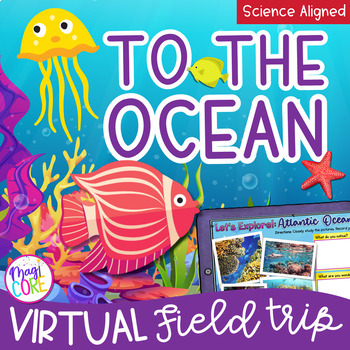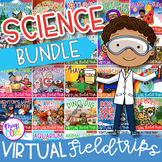Virtual Field Trip Ocean Habitat & Animals Google Digital Resource Activities

What educators are saying
Also included in
- ⭐️Let's all take a field trip! This GROWING bundle contains a variety of virtual field trips suitable for 2nd - 5th grade students. Students visit New York City, go on a safari in the African savanna, accompany paleontologists on a dinosaur dig, and much more. There are over 80 destinations and morePrice $219.50Original Price $340.25Save $120.75
- ⭐️Let's all take a field trip! This GROWING bundle contains a variety of science-based virtual field trips suitable for 2nd - 5th grade students. All field trips incorporate NGSS standards. Students go storm chasing, go on a safari in the African savanna, accompany paleontologists on a dinosaur dig,Price $79.50Original Price $94.50Save $15.00
Description
⛵ Dive into an undersea world with this incredible cross-curricular Virtual Field Trip to the Ocean! This virtual field trip activity is an absolute treasure trove of fascinating information about our Earth's oceans and the creatures that inhabit them. With an array of video links, images, reading passages, exercises, maps, and more, students will be mesmerized as they practice key skills and explore the awe-inspiring world beneath the waves.
⚓ In this Virtual Field Trip to the Ocean, your students learn about essential scientific concepts like adaptation and biodiversity. Integrated thought-provoking exercises, reading and writing assignments, and links to educational videos help students develop skills in reading comprehension, writing, multimedia, science, and much more.
⛴ This Virtual Field Trip to the Ocean is a must-have for any teacher looking to provide their students with an engaging and enriching learning experience. Your students will be captivated and inspired as they explore the wondrous world beneath the waves!
This resource aligns with the following NGSS Standards:
Aligned with NGSS standards, this virtual field trip emphasizes the importance of understanding the relationships between populations and their habitats.
⇨ LS4.C: Adaptation
- For any particular environment, some kinds of organisms survive well, some survive less well, and some cannot survive at all. (3-LS4-3)
⇨ LS4.D: Biodiversity and Humans
- Populations live in a variety of habitats and change in those habitats affects the organisms living there. (3-LS4-4)
*Please note: This resource includes links to YouTube videos, so ensure you and your students have access to YouTube before purchasing. Although great care has been taken to ensure all content is appropriate for the stated grade levels, each classroom is unique and it is recommended that teachers review all content prior to use. I recommend embedding the videos to avoid ads and other content that may be inappropriate. Instructions for embedding the videos are included and it should only take a few minutes. Also, keep in mind that any links to third-party content may be changed or removed by the content owner. All links are reviewed regularly; however, if you find a broken link, please let me know so I can update the resource accordingly.
Features:
✏️Google Slides & Seesaw Formats - These interactive formats are perfect for engaging no prep activities in any classroom with access to a device. Slides are interactive and can be used as a fun and engaging exercise within the classroom or at home.
✏️Engaging Interactive Maps & Virtual Video Tours - Interactive maps & virtual video tours take students inside the action.
✏️Reading Comprehension - Integrates key reading skills like compare & contrast, multimedia, multiple sources, and more.
✏️Writing & Science - Virtual field trip helps students understand more about the world around them and uses writing prompts to explore their reactions and ideas.
What's Included?
- Earth's Oceans Video & Map
- Marine Biologist Job Description & Video
- Ticket to the Ocean!
- Pacific Ocean Passage
- Kelp Forest Video
- Mariana Trench Video
- Atlantic Ocean Photo Observation
- Animal Partnerships Video
- Bottlenose Dolphin Adaptations
- Indian Ocean Seagrasses & Dugongs
- Arctic Ocean: Whale & Walrus Adaptations
- Southern Ocean Passage
- Research Notes
- Other Places to Explore!
*Answer Key Included
This resource is suitable for the following grade levels:
- 2nd & 3rd Grade: With teacher modeling, whole class, or small groups.
- 4th & 5th Grade: Independent for on-level students.
Time to Complete:
This virtual field trip takes approximately 45 minutes to 1 hour to complete. The time it takes to complete can vary based on your students. It can be completed in one session or broken up into multiple sessions.
How to Use a Virtual Field Trip:
This Virtual Field Trip to the Ocean is the perfect activity for:
⭐️ Fun Fridays
⭐️ Rewards
⭐️ End of Science Unit
⭐️ Whole Class
⭐️ Small Groups
⭐️ Enrichment
⭐️ Centers
There are so many ways to use these engaging and meaningful activities in your classroom. If you're looking for more ways to explore learning with Virtual Field Trips you can LEARN MORE here.
Popular Related Products:
✈️ Social Studies Virtual Field Trips - GROWING BUNDLE
✈️ Chocolate Virtual Field Trip - Google Slides & Seesaw Distance Learning Formats
✈️ Social Studies Virtual Field Trip One-Room Schoolhouses
✈️ Storm Chasing Virtual Field Trip - Google Slides & Seesaw Distance Learning
Copyright & Terms of Use:
For copyright information and a summary of how this resource can and cannot be used, please review the Terms of Use Page.
Customer Tips:
How to get TPT credit to use on future purchases:
- Please go to your My Purchases page (you may need to log in). Beside each purchase, you'll see a Provide Feedback button. Simply click it and you will be taken to a page where you can give a quick rating and leave a short comment for the product. Each time you give feedback, TPT gives you feedback credits that you use to lower the cost of your future purchases. I value your feedback greatly as it helps me determine which products are most valuable for your classroom so I can create more for you. ☺
Be the first to know about my new discounts, freebies, and product launches:
- Look for the green star next to my store logo and click it to become a follower. Voila! You will now receive email updates about this store. ☺
- Follow me on Facebook for updates on new products and sales
- Follow me on Instagram
- Join my email list by visiting my website and receive a free resource
*****************************************************************************







